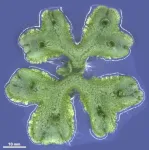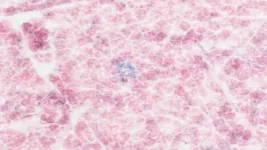(Press-News.org) A new mobile phone-based facial recognition application for dogs has the potential to significantly improve rabies vaccination efforts in endemic areas like Africa and Asia, according to a study on the research published in the journal Scientific Reports.
Led by researchers at Washington State University, a team used the app to test its effectiveness at a rabies vaccination clinic in rural Tanzania where they microchipped, vaccinated and registered dogs. The technology proved remarkably accurate during a subsequent visit to surrounding villages once poor images and improperly recorded information were removed from its database. Using the app, operators identified 76.2% of vaccinated dogs and 98.9% of unvaccinated dogs.
“Because domestic dogs are the main reservoir for human rabies, controlling human rabies globally requires the mass vaccination of dogs,” WSU Associate Professor Felix Lankester, the principal investigator of the study, said. “When carrying out mass vaccination, one of the major problems that we face is trying to identify which dogs have and haven’t been vaccinated. For example, microchips are too expensive to use at the scales needed to eliminate rabies, and collars can be removed by owners. We developed this app to see if facial recognition might work, and it’s showing great promise in helping us to achieve that goal.”
Rabies kills an estimated 60,000 people annually. Nearly all cases occur in Africa and Asia, and more than 99% are the result of dog bites. Systematic and consistent vaccination efforts, like those led by WSU’s Rabies Free Africa program, are effective at controlling the disease, but approximately 40% of dogs in an area must be vaccinated at any one time to achieve herd immunity and prevent sustained virus transmission. This makes the ability to accurately and efficiently identify vaccinated dogs vital for successful rabies elimination programs.
The facial recognition algorithm used within the application, developed in collaboration with PiP My Pet, a company located in Vancouver, Canada, and researchers in WSU’s Paul G. Allen School for Global Health, identifies a dog by examining key components of its face and comparing it to images of the faces of other dogs in its archive of previously stored images. Images with the highest number of similar components are returned as possible matches, and the user must decide if there is a match.
The app depends on image quality and information about each dog, including its age, color and sex, being properly recorded. Before poor quality images and incorrect information were removed from the database, users were only able to match 65% of the vaccinated dogs.
Lankester, who also serves as a director of Rabies Free Africa, said the app’s effectiveness could be improved with better technology – like newer smartphones with high-quality cameras – and additional operator training.
In addition to its potential as a tool in identifying vaccinated dogs, the technology holds promise for use in other species, disease control efforts and research purposes where animals might need to be identified.
Currently, users must be online to operate the facial matching component, however, Lankester said the team is also working to compress the size of the “engine” that drives the app’s matching facility to allow it to be downloaded and used offline, which would reduce the app’s reliance on internet access, which is not always available in more remote areas.
“We’re not quite there yet, but I think with investment, the technology can get there. I’m excited by its potential,” Lankester said, “but we have to find some funding to invest in pushing it forward. I welcome people to get in touch if they have funding ideas or would like to collaborate on this.”
END
Facial recognition app for dogs developed to help in fight against rabies
2024-01-24
ELSE PRESS RELEASES FROM THIS DATE:
New study unveils how plants control the production of reactive oxygen species
2024-01-24
Reactive oxygen species (ROS) are highly reactive molecules containing oxygen. These compounds, which are normal byproducts of biological processes in all living organisms such as aerobic respiration as well as photosynthesis, are highly toxic. In most cases, ROS damage cellular machinery and can trigger a harmful stress response if their levels are not kept in tight check; this is why antioxidants are an important part of our diet.
However, over the past few decades, scientists have discovered that ROS are often intentionally ...
Rice study unlocks breakthrough for breast cancer bone metastases
2024-01-24
HOUSTON – (Jan. 24, 2023) – Rice University researchers in the lab of chemist Han Xiao have identified a promising new immunological pathway to treat stubborn bone tumors, one of most prevalent forms of metastases in breast cancer patients.
“More than 70% of people with metastatic breast cancer will see the cancer cells move to bone, which can lead to skeletal-related events like bone pain, fractures, and hypercalcemia,” said Yixian Wang, a Rice graduate student in the Han lab who is a lead author on a study published in Proceedings of the National Academy of Sciences. ...
The fountain of youth is … a T cell?
2024-01-24
The fountain of youth has eluded explorers for ages. It turns out the magic anti-aging elixir might have been inside us all along.
Cold Spring Harbor Laboratory (CSHL) Assistant Professor Corina Amor Vegas and colleagues have discovered that T cells can be reprogrammed to fight aging, so to speak. Given the right set of genetic modifications, these white blood cells can attack another group of cells known as senescent cells. These cells are thought to be responsible for many of the diseases we grapple with later in life.
Senescent cells are those that stop replicating. As we age, they build up in our bodies, ...
Infants born to COVID-infected mothers have triple the risk of developing respiratory distress
2024-01-24
New UCLA-led research finds that infants born full term to mothers who were infected with COVID-19 during pregnancy had three times the risk of having respiratory distress compared with unexposed infants, even though they themselves were not infected with the virus. The risk was significantly lower when the mothers infected during pregnancy were previously vaccinated.
The researchers found that in-utero exposure to SARS-CoV-2 sparked an “inflammatory cascade” in the infants, increasing the risk of a breathing disorder that most often ...
More than half of US adults don’t know heart disease is leading cause of death, despite 100-year reign
2024-01-24
Highlights:
More than half (51%) of respondents in a 2023 Harris Poll survey conducted on behalf of the American Heart Association did not identify heart disease as the leading cause of death in the U.S.
According to the 2024 Heart Disease and Stroke Statistics: A Report of U.S. and Global Data From the American Heart Association, heart disease has been the leading cause of death in the U.S. for 100 years.
Heart disease along with stroke, which is the fifth leading cause of death, claimed more lives ...
Ultrafast excitations in correlated systems
2024-01-24
An international team of researchers from the European XFEL together with colleagues from the Max Born Institute in Berlin, Universities of Berlin and Hamburg, The University of Tokyo, the Japanese National Institute of Advanced Industrial Science and Technology (AIST), the Dutch Radboud University, Imperial College London, and Hamburg Center for Ultrafast Imaging, have presented new ideas for ultrafast multi-dimensional spectroscopy of strongly correlated solids. This work has now been published in Nature Photonics.
"Strongly correlated solids are complex and fascinating quantum systems in which new electronic states often ...
Chemotherapy becomes more efficient when senescent cells are eliminated by immunotherapy
2024-01-24
Barcelona, 24 January 2024 – Cancer treatments, including chemotherapy, in addition to killing a large number of tumour cells, also result in the generation of senescent tumour cells (also called “zombi cells”). While senescent cells do not reproduce, they do, unfortunately, generate a favourable environment for the expansion of tumour cells that may have escaped the effects of the chemotherapy and eventually result in tumour regrowth.
An international team of researchers led by Dr. Manuel Serrano at IRB Barcelona have described how cancer cells that have become senescent after ...
TRAILS AI Institute announces first round of Seed Funding
2024-01-24
The Institute for Trustworthy AI in Law & Society (TRAILS) has unveiled an inaugural round of seed grants designed to integrate a greater diversity of stakeholders into the artificial intelligence (AI) development and governance lifecycle, ultimately creating positive feedback loops to improve trustworthiness, accessibility and efficacy in AI-infused systems.
The eight grants announced on January 24, 2024—ranging from $100K to $150K apiece and totaling just over $1.5 million—were awarded to interdisciplinary ...
Cognitive behavioral therapy alters brain activity in children with anxiety
2024-01-24
Researchers at the National Institutes of Health have found overactivation in many brain regions, including the frontal and parietal lobes and the amygdala, in unmedicated children with anxiety disorders. They also showed that treatment with cognitive behavioral therapy (CBT) led to improvements in clinical symptoms and brain functioning. The findings illuminate the brain mechanisms underlying the acute effects of CBT to treat one of the most common mental disorders. The study, published in the American Journal of Psychiatry, was led by researchers at NIH’s ...
Do different plant-based diets affect pregnancy and birth outcomes?
2024-01-24
Women who follow vegan diets during pregnancy may face higher risks of developing preeclampsia and of giving birth to newborns with lower birth weight, suggests a recent study published in Acta Obstetricia et Gynecologica Scandinavica.
For the study, 65,872 women identified themselves as omnivorous, 666 as fish/poultry vegetarians, 183 as lacto/ovo vegetarians, and 18 as vegans. Based on a questionnaire completed mid-pregnancy, investigators found that protein intake was lower among lacto/ovo vegetarians (13.3%) and vegans (10.4%) compared with omnivorous participants (15.4%). Micronutrient intake was also ...








